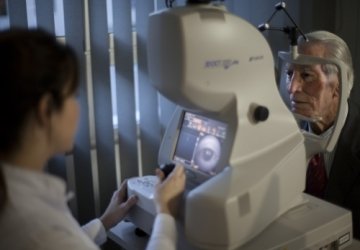Optical Coherence Tomography, often referred to as OCT, is a modern, non-invasive imaging test that provides a detailed examination of the eye’s internal tissues, specifically the retina and the optic nerve. It uses light waves to take cross-section pictures, allowing your ophthalmologist to see each of the retina’s distinctive layers.
At Dr. Hantera Eye Clinic, this advanced procedure is overseen by Dr. Muhammed Hantera, Honorary Assistant Professor at the Ophthalmology Department of Umm Al-Qura University, ensuring the highest standards of care and accuracy.
How Does an OCT Scan Work?
The process is simple and quick. You will sit in front of the OCT machine and rest your head on a support to keep it still. The device then sends a beam of light into your eye. As this light reflects off the different layers of tissue, the machine measures the “echo” of the returning light waves.
Based on the time it takes for these waves to return, the system generates a detailed, cross-sectional, and colored image of the eyeball’s inner components. This allows us to measure the thickness of different tissues, such as the nerve fiber layer, to diagnose and track the progression of various eye diseases.
Preparing for Your OCT Examination
To ensure we get the clearest possible image, drops may be used to dilate your pupils. It’s important to be aware of the following:
- Temporary Side Effects: The only side effect from the dilating drops is temporary blurred vision and sensitivity to light. This typically lasts for up to 4-6 hours.
- Driving After the Exam: Due to the temporary blurred vision from the drops, driving is not recommended for up to 4 hours after the examination. We advise arranging for someone to drive you home.
Understanding Your Examination Results
The OCT scan provides valuable insights into the health of your eyes.
- In a Healthy Eye (for Men, Women, and Children): The scan results will show a normal, healthy structure and thickness for both the retina and the optic nerve.
- Detecting Abnormalities: If any abnormalities are present, the OCT can detect minute changes in tissue thickness or structure, helping in the early diagnosis and effective management of eye conditions.
Frequently Asked Questions about OCT
1. Is the OCT scan painful?
No, the procedure is completely painless and does not involve any physical contact with your eye.
2. How long does the scan take?
The scan is very fast, usually taking only 5 to 10 minutes per eye.
3. Who should get an OCT scan?
It is highly recommended for patients with or at risk for retinal conditions (like diabetic retinopathy), glaucoma, age-related macular degeneration, or anyone seeking a comprehensive check-up of their retinal health.
Protect your vision with early detection. To learn more or to schedule your OCT scan, contact Dr. Hantera Eye Clinic today.



